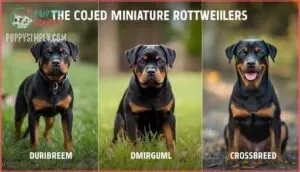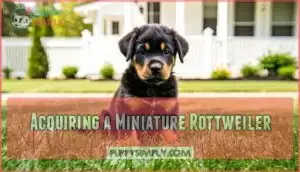This site is supported by our readers. We may earn a commission, at no cost to you, if you purchase through links.

Some are purebred Rottweilers with dwarfism, which sounds cute but creates serious joint problems. Others come from breeding the smallest runts in litters, passing along genetic weaknesses like a bad game of telephone.
The third type mixes Rottweilers with smaller breeds like Chihuahuas or Beagles. While these compact companions might fit your apartment lifestyle, they often struggle with breathing issues, heart defects, and shorter lifespans.
It’s like squeezing a full-sized personality into a travel-sized package—something’s bound to get cramped. Understanding their origins reveals why size matters more than you’d think, and this is crucial for the health and wellbeing of these animals, as they can have a full-sized personality.
Table Of Contents
- Key Takeaways
- Miniature Rottweiler Origins
- Health Considerations
- Temperament and Appearance
- Acquiring a Miniature Rottweiler
- Growth and Development
- Frequently Asked Questions (FAQs)
- How much exercise does a miniature Rottweiler need?
- How long do miniature Rottweilers typically live?
- Are miniature Rottweilers good with children?
- Are there any specific dietary needs for miniature Rottweilers?
- How much grooming do miniature Rottweilers require?
- Are miniature Rottweilers officially recognized by kennel clubs?
- What is the typical lifespan of miniature Rottweilers?
- Do miniature Rottweilers require special dietary considerations?
- Can miniature Rottweilers live in small apartments?
- How much exercise do miniature Rottweilers need daily?
- Conclusion
Key Takeaways
- You won’t find a true miniature Rottweiler breed; they’re either runts, dogs with dwarfism, or crossbreeds, all carrying potential health risks.
- Breeding runts or dwarf Rottweilers often leads to genetic issues like joint problems, heart defects, and shorter lifespans.
- Crossbreeding with smaller breeds creates compact dogs, but they can inherit unpredictable health and temperament traits.
- Always prioritize ethical breeders or adoption to avoid supporting harmful breeding practices and ensure the dog’s well-being.
Miniature Rottweiler Origins
You’ll find that miniature Rottweilers come from three main sources: purebred Rottweilers with dwarfism, breeding from the smallest puppies in litters, or crossbreeding with smaller dog breeds.
These methods create dogs that look like tiny Rottweilers but carry different health risks and genetic backgrounds that you need to understand before choosing one, especially considering the potential impact of genetic backgrounds.
Purebred Rottweilers With Dwarfism
When purebred Rottweilers develop dwarfism genetics, you’re looking at serious skeletal issues that don’t meet breed standard requirements.
This rottweiler dwarfism stems from genetic mutations affecting the mini rottweiler’s bone development.
Ethical breeding practices avoid producing these small rottweiler variants because the lifespan impact is severe.
One common cause is a failure of the pituitary gland, leading to insufficient growth hormone production.
The rottweiler breed shouldn’t intentionally carry these harmful traits forward through breeding programs.
Bred From Litter Runts
Some breeders create mini rottweiler dogs by mating runts from different litters.
Runts face serious runt health risks including 39% higher mortality rates and skeletal weaknesses.
This approach raises ethical breeding concerns since runt status doesn’t guarantee small rottweiler size inheritance.
Most runts actually grow to standard rottweiler weight with proper care, making size variability unpredictable traits that affect lifespan expectations.
Miniature Rottweilers are often created by crossing a Rottweiler with smaller dog breeds.
Rottweiler Mixes
Another route to smaller Rottweilers involves crossbreeding with toy breeds.
Popular Rottweiler Mixes like Rottie-Chihuahua or Rottie-Pomeranian combinations create Designer Rottweilers that inherit size variations from both parents.
These hybrid dogs show Temperament Variations depending on which parent they favor more.
While Hybrid Health can improve through genetic diversity, you’ll need specialized Mixes Grooming routines for different coat types.
Health Considerations
You’ll need to understand the serious health risks that come with miniature Rottweilers before you decide to get one.
These smaller dogs often face genetic problems and breeding issues that can lead to expensive vet bills and heartbreak for their families, which can result in heartbreak.
Risks of Breeding Runts
When you’re tempted by that tiny rottweiler puppy, remember that breeding runts creates a cascade of problems.
These undersized dogs carry genetic disorders that responsible rottweiler breeders actively avoid. The practice raises serious ethical concerns about puppy health and welfare.
- Lifespan reduction – Runts live substantially shorter lives due to accumulated health burdens
- Genetic disorders – Higher rates of heart defects, skeletal problems, and immune deficiencies
- Unpredictable size – No guarantee your teacup rottweiler will stay small across generations
- Rottweiler health – Compromised immune systems persist throughout their lives, increasing veterinary costs
Health Issues With Dwarfism
Dwarfism creates a cascade of problems for your teacup rottweiler.
Skeletal deformities affect 100% of cases, causing joint problems and spinal issues.
Organ problems emerge early, with cardiac anomalies in 23% of pups.
Your toy rottweiler faces serious lifespan concerns—averaging just 4-5 years without treatment.
Genetic testing before breeding helps identify these devastating rottweiler health risks.
Spinal issues can be exacerbated by intervertebral disc disease.
Lack of Regulations
The miniature dog world operates like the Wild West with minimal breeder accountability.
Puppy mills exploit this gap, selling unhealthy toy rottweiler puppies without genetic screening.
You’ll find no consumer protection laws requiring health testing or ethical breeding standards.
This means higher rottweiler price tags don’t guarantee quality, and smart buyers research thoroughly before considering rottweiler adoption for proper rottweiler care.
Adopting a Mix Instead
Consider adopting a rottweiler mix instead of pursuing miniature breeding.
Mix breed benefits include genetic diversity and reduced health risks compared to dwarf Rottweilers.
Shelter adoption supports ethical considerations while providing loving homes for dogs needing families.
Rottweiler mixes often retain classic rottweiler temperament and characteristics. You’ll find rottweiler information helpful when researching available mixed breeds at local shelters.
Temperament and Appearance
You’ll find that miniature Rottweilers maintain the same bold, confident personality as their full-sized relatives while fitting into a smaller package.
These compact companions typically weigh between 30-60 pounds and display the classic black and tan coat pattern that makes Rottweilers instantly recognizable.
Friendly Yet Independent
You’ll find miniature Rottweilers strike a perfect balance between warmth and independence.
Their rottweiler temperament shines through with moderate affection levels – they’re not clingy lap dogs but enjoy quality time with family.
These dogs handle alone time better than most breeds, making them ideal for busy households.
Their rottweiler characteristics include loyalty without being overly demanding of constant attention.
Single owners may find that independent dog breeds are a good fit due to their self-reliance.
Training and Socialization
Your miniature Rottweiler’s independent streak means you’ll need patience during rottweiler training sessions.
Early socialization and obedience training work best with positive reinforcement methods. Start leash manners young to prevent pulling issues later.
Many owners find specialized training products helpful during this process.
Key training priorities include:
- Addressing aggression through consistent boundaries and calm leadership
- PC interaction training for modern household behaviors
- Daily socialization to build confidence around strangers
Similarities to Other Breeds
Looking beyond size differences, you’ll notice miniature Rottweilers share temperament parallels with Dobermans and German Shepherds.
These breed comparisons reveal similar protective instincts and loyalty traits.
Physical resemblances include sturdy builds and alert expressions, though genetic overlap varies by breeding method.
Behavioral traits mirror their full-sized cousins – they’re naturally confident guardians who respond well to consistent rottweiler training throughout their shorter rottweiler lifespan.
Acquiring a Miniature Rottweiler
When you’re ready to bring home a miniature Rottweiler, you’ll need to research breeders carefully and prepare for higher costs than standard puppies.
Finding a healthy dog requires checking the breeder’s reputation, asking about health testing, and scheduling a vet visit right after you get your new pet.
Pricing and Reputable Breeders
You’ll shell out anywhere from $350 to $3,500 for a miniature Rottweiler puppy, depending on breeder reputation and lineage quality.
Finding your perfect miniature Rottweiler means investing in quality – prices reflect the breeder’s commitment to your future companion’s health.
Reputable breeders typically charge $1,000-$3,500, reflecting their ethical breeding practices and health guarantees.
The American Rottweiler Club’s referral program connects you with trusted breeders who prioritize puppy health over profit, ensuring your digital assistant research pays off.
Important Considerations
Beyond price tags, you’ll face bigger decisions when acquiring a miniature Rottweiler.
Ethical breeding practices matter more than flashy websites or Windows screenshot galleries showing cute puppies.
Research genetic health testing, verify responsible ownership requirements, and understand their specific exercise needs and diet requirements.
Finding mini rottweiler breeders online is common.
Don’t rush this choice – your future companion’s wellbeing depends on thorough preparation and commitment.
Vet Visit and Health Check
Schedule your first vet visit immediately after bringing your miniature Rottweiler home.
Your vet will establish a vaccination schedule and discuss parasite prevention strategies. They’ll assess dental care needs and create a weight management plan suited to your dog’s size.
Remember, consistent monitoring is key to optimal dog health. Document exercise needs and health recommendations – take a screenshot of care instructions using your phone’s screen capture feature for easy reference, and check out optimal dog health for more information.
Growth and Development
You’ll find that miniature Rottweilers don’t follow standard breed development timelines due to their varied origins and genetic backgrounds.
These dogs reach their full size much earlier than regular Rottweilers, typically completing their growth between 8-12 months rather than the usual 18-24 months, which can be considered a complete development in a shorter timeframe, and this is a key factor in their genetic makeup.
Smaller Standard Rottweilers
Sometimes the quest for a miniature rottweiler leads you to smaller standard rottweilers instead. These dogs fall within official breed standards but represent the lower end of the size spectrum.
Genetic factors naturally create size variations within any dog breed, making some rottweilers smaller than others.
- Female rottweilers typically weigh 80-100 pounds versus males at 95-135 pounds
- Ethical breeding practices focus on health rather than deliberately reducing size
- Health implications remain minimal when dogs meet standard breed requirements
- Canine traits and temperament stay consistent regardless of size within standards
- Small rottweilers from reputable breeders offer a healthier alternative to forced miniaturization, which is a key aspect of healthy breeding and ensures the dogs’ overall well-being.
Growth Patterns
Understanding your miniature Rottweiler’s growth stages helps you track their development properly.
Size variation depends on genetic factors and environmental impact from nutrition to exercise.
You’ll notice weight fluctuations during different periods – monitor these changes like taking a screenshot of their progress.
Regular weight monitoring lets you capture their growth patterns and adjust care accordingly.
Many owners track mini rottweiler growth with specific products to ensure they are providing the best possible care for their Rottweiler’s development.
Developmental Stages
Your miniature Rottweiler will hit key puppy milestones during their first year, then face adolescent changes around 12-18 months.
Adult maturity arrives by age two, while senior care becomes essential after seven years.
Lifespan factors vary substantially based on breeding methods.
Like other large breeds, miniature Rottweilers require early socialization to avoid issues during their fear imprint period.
- Puppyhood brings rapid growth spurts that’ll melt your heart
- Adolescence tests your patience with stubborn streaks
- Senior years reward you with gentle, wise companionship
Frequently Asked Questions (FAQs)
How much exercise does a miniature Rottweiler need?
Sixty minutes daily keeps most small dogs happy and healthy.
You’ll need thirty minutes of walking plus thirty minutes of play or training.
Think fetch, puzzle toys, or agility games to tire out that sharp mind.
How long do miniature Rottweilers typically live?
Your pint-sized companion will likely stick around for 12-15 years, though some genetics and care can stretch that timeline.
Smaller dogs often outlive their larger cousins, so you’ll have plenty of time together.
Are miniature Rottweilers good with children?
About 70% of dog owners say temperament matters most.
Miniature Rottweilers can be great with kids if socialized early.
They’re loyal and protective but need training to manage energy and guarantee gentle play around younger children.
Are there any specific dietary needs for miniature Rottweilers?
Your pup needs a balanced diet with high-quality protein, healthy fats, and essential vitamins.
Avoid overfeeding to prevent weight issues.
Small breeds thrive on portion control, so stick to recommended serving sizes and consult your vet.
How much grooming do miniature Rottweilers require?
You’ll need to brush them weekly to manage shedding and keep their coat shiny.
Regular nail trims, ear checks, and occasional baths help too.
They’re low-maintenance compared to fluffier breeds, but consistency is key!
Are miniature Rottweilers officially recognized by kennel clubs?
Think of official kennel clubs as exclusive clubs with strict entry rules.
Miniature Rottweilers aren’t recognized by major ones like the AKC.
They’re more of a designer breed, gaining popularity outside traditional breed standards.
What is the typical lifespan of miniature Rottweilers?
Miniature Rottweilers, often mixed breeds, typically live around 10 to 12 years.
Their lifespan depends on genetics, diet, exercise, and regular vet care.
Providing a healthy lifestyle can help them stay active and happy longer, which is influenced by factors such as diet and regular care.
Do miniature Rottweilers require special dietary considerations?
Feeding a smaller dog doesn’t mean less thought.
You’ll need a high-quality, protein-rich diet with balanced fats.
Watch portion sizes because weight issues can sneak up fast.
Stick to foods suited for small, active breeds.
Can miniature Rottweilers live in small apartments?
Yes, they can! Miniature Rottweilers adapt well to small apartments if you exercise them daily.
A brisk walk and some indoor play should do the trick.
Just keep them mentally stimulated to avoid boredom.
How much exercise do miniature Rottweilers need daily?
You’d think a smaller dog means less exercise, but nope!
Miniature Rottweilers need about 30-60 minutes daily.
Mix brisk walks, playtime, and mental challenges to keep them fit, happy, and out of trouble.
Conclusion
Nearly 60% of dogs with genetic issues face lifelong health challenges, and miniature Rottweilers are no exception.
Whether they’re bred from runts, have dwarfism, or are mixed with smaller breeds, their compact size often comes with serious health risks.
If you’re considering a miniature Rottweiler, prioritize their well-being by researching ethical breeders or adopting responsibly.
Regular vet checkups, proper training, and socialization are essential.
These small dogs may be adorable, but their care requires big responsibility.














